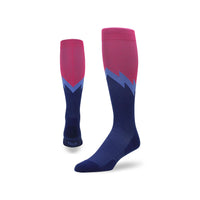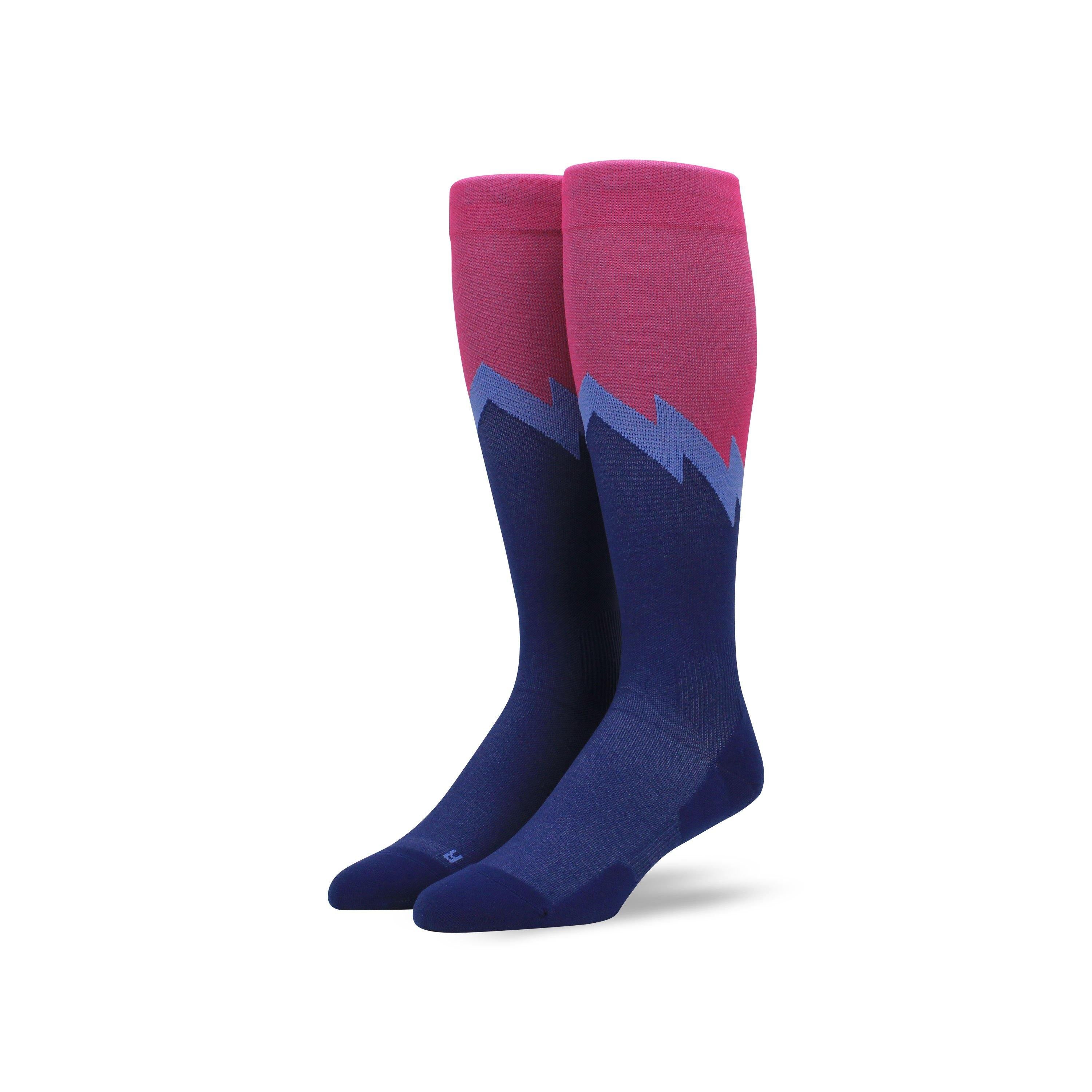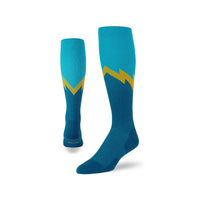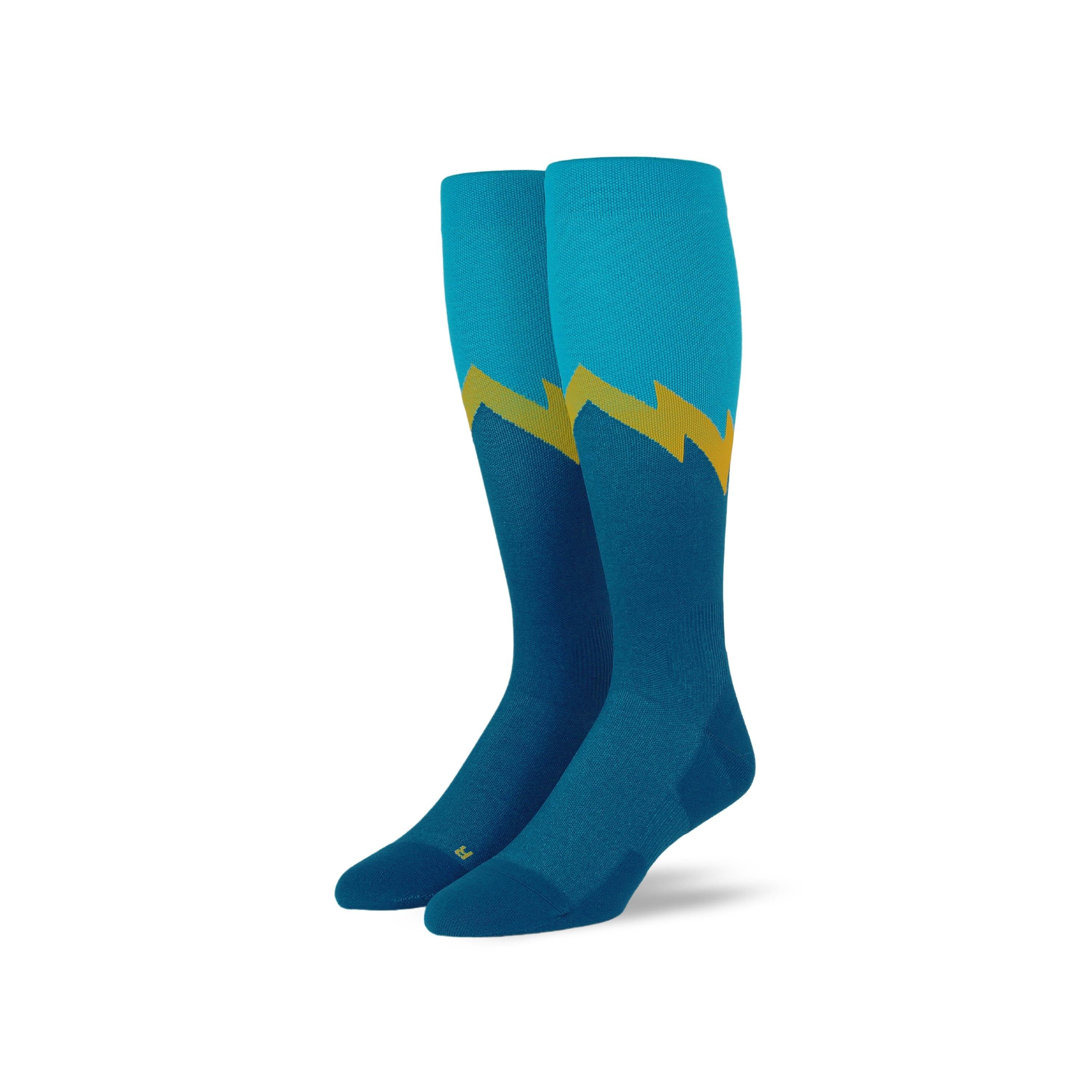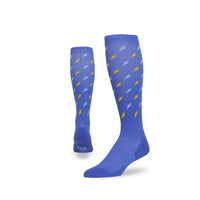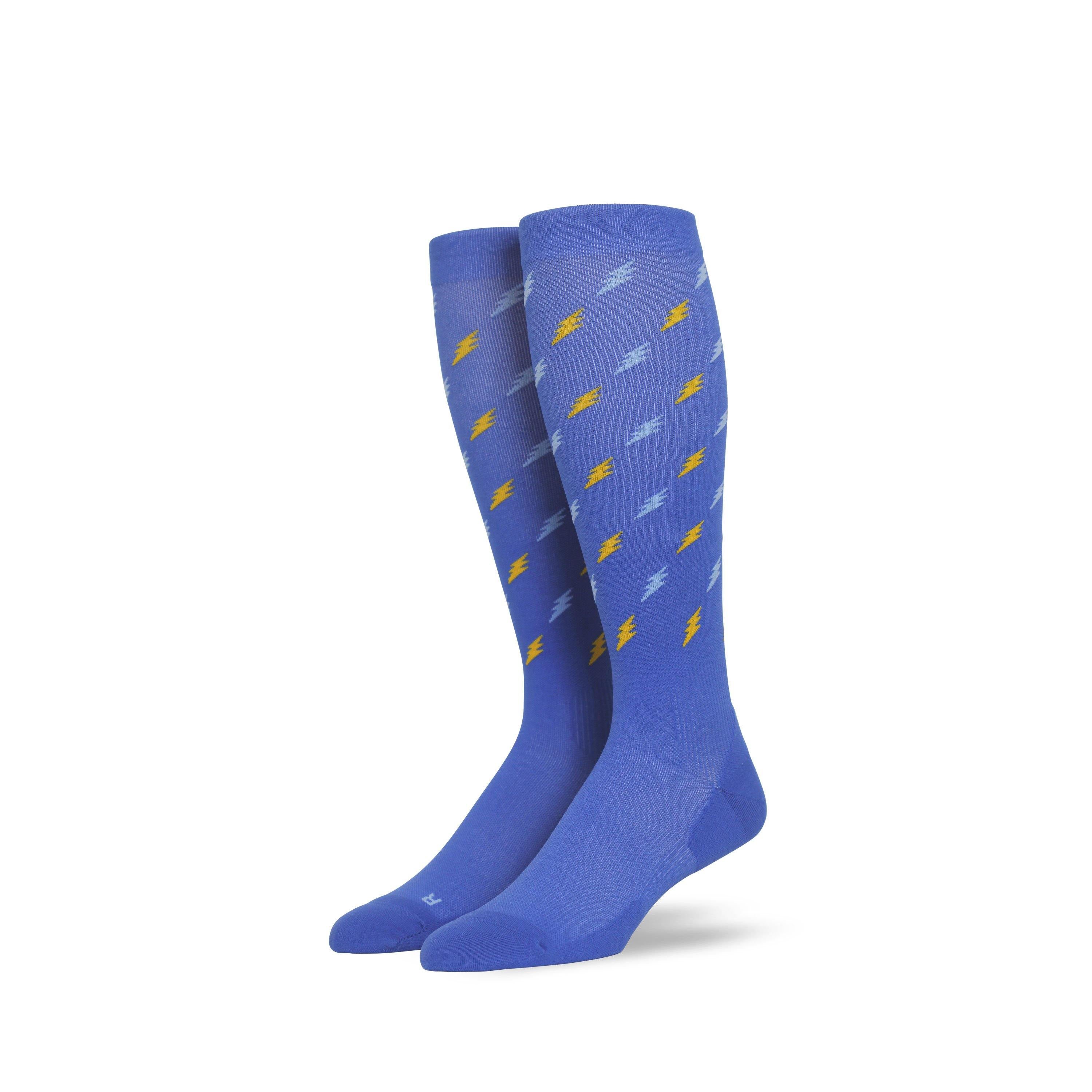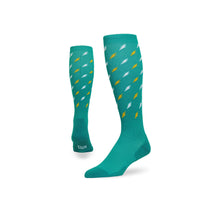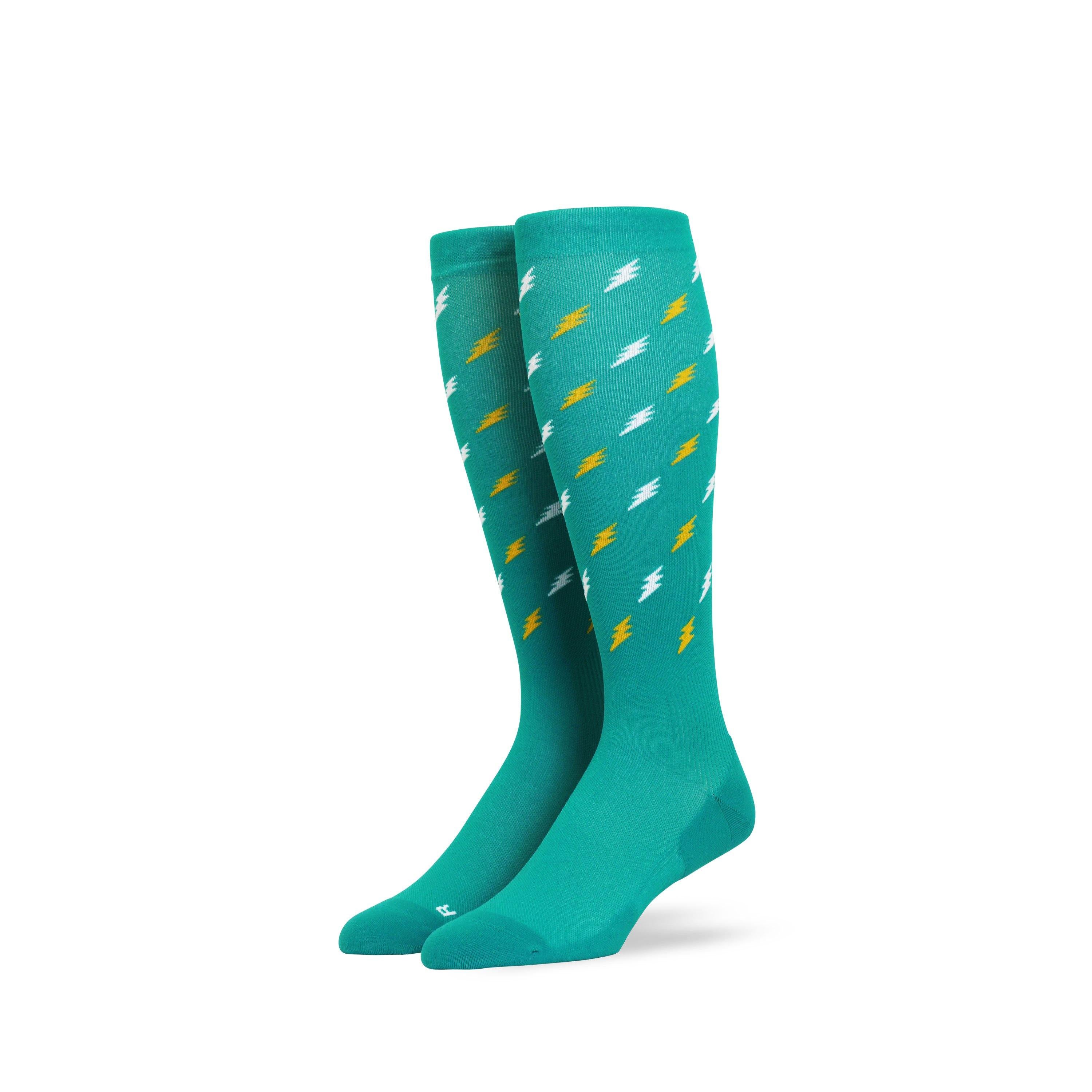Top 10 Reasons to Wear Compression Socks
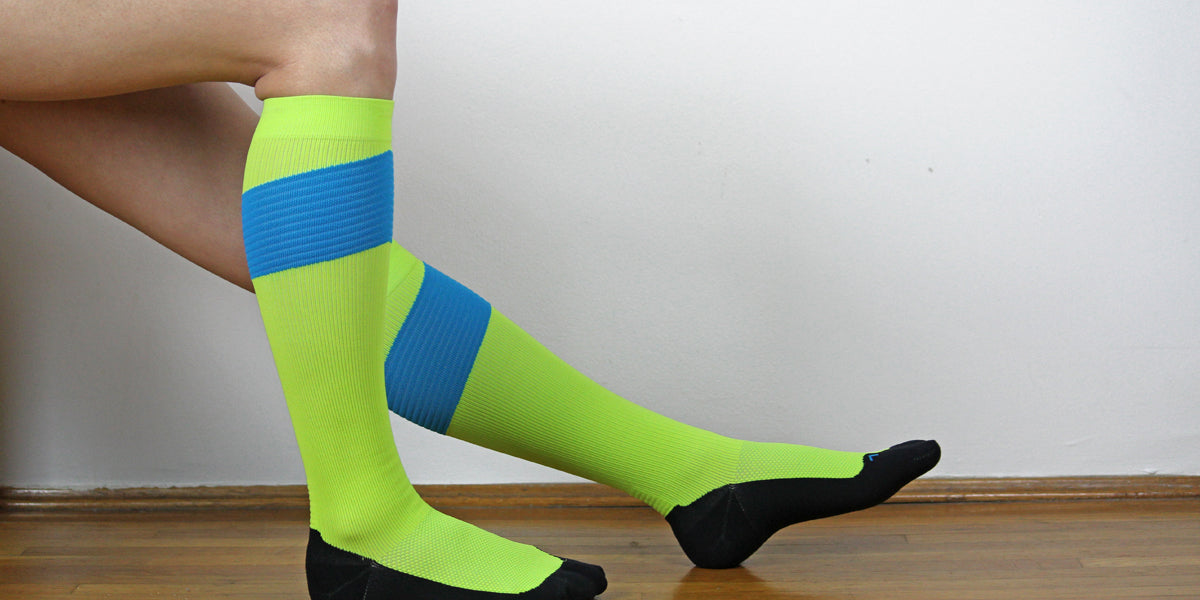
For most people, the use of compression socks evokes visions of elite marathoners, senior citizens, or bedridden hospital patients. However, there are numerous reasons compression socks can (and should!) be worn. Here, the top 10 reasons to wear compression socks will be discussed, as well as the technical details for their use.
How do Compression Socks Work?
Compression socks are knee-high, elastic socks that are pulled over the foot and generally rest below the knee. These garments are intended to compress the entire lower leg, including feet, ankles, and calves. Compression socks are constructed from strong elastic or rubber fibers, which apply compression to the feet, ankles, calves, and shins.
When compression socks are worn, the compression works to reduce the diameter of veins in the lower legs. This reduction results in increased blood flow velocity. In addition, the reduction of vein diameter improves the effectiveness of the valves in both veins and arteries. The overall effect is reduced venous pressure, enhanced circulation, and greater venous wall support. Overall, when veins, muscles, and arteries are compressed and circulating blood is forced through these small channels, venous return (i.e., the flow of blood back to the heart) is significantly improved.
Graduated Compression Socks
Graduatedcompression socks are worn by ambulatory patients and have varying levels of compression throughout the sock. The level of compression will be highest toward the feet and will continue to decrease until the lowest level of compression is experienced at the top cuff. Graduated compression is used to fight gravity by pushing blood flow and edema toward the heart. As blood pools in the lowest portions of the body, it is difficult for the body to return the inflammation and blood back to the heart for recirculation. However, gradient compression causes the highest level of constriction in the feet, which pushes blood upwards. The result is greater venous return.
The most common style of compression socks are knee-high, which rest just below the knee. This style is preferred by many people as being most comfortable and easy to wear.
What to Look for When Purchasing Compression Socks
When selecting the best compression socks, do you know which type of socks should you choose? There are many choices available, including various lengths, compression grades, and purposes.
First, when choosing compression socks it is important to note the style. Knee-high compression socks, which cover the entire lower leg from toe to just below the knee, are the preferred style by many medical professionals.
Second, you should find compression socks that have an appropriate level of compression for your needs. The levels of compression are as follows:
- 8-15 mmHg: relieves minor swelling
- 15-20 mmHg: prevents and relieves minor varicose veins; prevents deep vein thrombosis; ideal for travel
- 20-30 mmHg: prevents and relieves moderate to severe varicose veins; treats moderate to severe edema; prevents deep vein thrombosis
- 30-40 mmHg: prevents and relieves severe varicose veins; treats severe edema; prevents deep vein thrombosis
If you are unsure which level of compression is best for your needs, consult a physician.
The third step in choosing the best compression socks for your needs is to take proper measurements. For knee-high socks, you should first record the circumference of your calf by measuring the widest part of your lower leg. This measurement, in addition to your shoe size, is used to determine which compression sock size is best for you.
Top 10 Reasons to Wear Compression Socks
There are many reasons to wear compression socks, regardless of your age, gender, or presence of any pre-existing medical condition. The top 10 most common reasons to wear compression socks include:
Compression Socks Improve Athletic Performance
Compression socks improve athletic performance by enhancing blood flow to and from lower extremities during activity. When training, hard-working muscles utilize oxygen-rich blood for fuel, then create deoxygenated metabolic waste products, such as lactic acid. This lactic acid build-up can cause muscle soreness and fatigue. Compression socks, however, improve circulation and blood flow, keeping deoxygenated blood from pooling in the lower legs and preventing lactic acid formation. If you look at the starting line of any race, you will find elite runners wearing compression socks, both men and women alike.
Additionally, compression socks also enhance post-exercise recovery. As soon as an athlete has finished exercising, the immune system goes to work repairing any damage that was sustained. Mediators and white blood cells are released to initiate repair, which results in swelling and discomfort. Compression socks speed up the recovery process by reducing swelling and inflammation to help muscles recover at a faster rate.
Compression Socks Reduce Edema and Swelling
Compression socks have many uses, both in the athletic and medical environments. Compression socks can be worn to reduce the build-up of fluids in the lower legs. For instance, women might wear compression socks to reduce edema and swelling in their feet and ankles during pregnancy. In a similar manner, diabetic patients may utilize compression socks to keep swelling in the feet to a minimum. People with varicose veins can also benefit from graduated compression. Hospital patients that are bedridden rely on compression socks to keep blood from pooling in lower legs and feet, as well as to prevent potentially life-threatening blood clots. By improving blood circulation and preventing blood from pooling, compression socks are able to significantly reduce swelling and edema.
Compression Socks Decrease Risk of Blood Clot and Deep Vein Thrombosis
For frequent travelers, the best compression socks are those that prevent blood clots from forming during long flights. When people spend prolonged periods of time sitting, they are more likely to develop dangerous blood clots in their lower legs which can lead to life-threatening events such as deep vein thrombosis and pulmonary embolism
Thanks to graduated compression technology, compression socks can prevent blood from pooling in the lower limbs while improving the wearer’s circulation. Ultimately, travelers are less likely to experience these dangerous conditions, particularly during long trips.
In addition, if you have suffered from deep vein thrombosis, wearing compression socks may be prescribed as treatment to prevent complications from occurring. One common complication is post-thrombotic syndrome, which results in lingering pain. The use of compression socks has been shown to decrease pain for these patients.
Compression Socks Prevent Varicose and Spider Veins
A hallmark of growing older is the development of raised, blue veins on the lower legs. Varicose veins are caused by venous insufficiency, meaning that poor circulation reduces the blood’s ability to flow back toward the heart. When venous insufficiency occurs, blood does not return to the heart and instead pools in the veins, causing them to become enlarged. Varicose veins can be dangerous because they increase the risk of developing blood clots and ulcers, and can burst.
While varicose veins are primarily experienced by aging adults, they can also occur in younger individuals. Up to 30% of women develop varicose veins during pregnancy due to hormonal changes that increase blood coagulation. Compression socks are useful for treating and preventing varicose veins because graduated compression prevents blood from pooling in veins while counteracting venous insufficiency.
Compression Socks Increase Muscular Stability
For people who are on their feet all day, such as athletes and those who have jobs that require a lot of walking, muscular vibration (also called oscillation) occurs at a significantly higher rate. Every time the foot strikes the ground, either when walking or running, a load is placed on the muscles. Over time, the muscles continue to move back and forth. This lateral movement reduces stability in the legs and can also result in injury, swelling, and fatigue.
By applying compression to the muscles, lateral movement and oscillation are reduced. In turn, the muscles are provided stability which improves overall efficiency and muscular economy.
Compression Socks Reduce Soreness and Cramping
If you come home from the end of a long day and the first thing you do is sit down and put your feet up, compression socks might be right for you. Athletes, as well as those who work on their feet all day, benefit from compression socks because they reduce associated muscle soreness and cramping. Indeed, the best compression socks make it less tiring for people to be on their feet all day.
There are many people who can benefit from wearing compression socks at work. Nurses, factory workers, teachers, dentists, dental hygienists, flight attendants, and anyone who must stand for prolonged periods of time will experience reduced pain and swelling during and after work, as well as enhanced recovery for the next day. Legs will feel energized and refreshed with the use of compression, instead of tired, sore, and swollen.
Compression Socks Help Injuries Heal
There are numerous injuries that affect the lower legs which can be addressed with the usage of compression. In fact, compression is commonly recommended as a treatment for acute injuries and is part of the RICE acronym, which stands for rest, ice, compression, and elevation. The types of injuries that compression can help to heal include:
Plantar Fasciitis
Plantar fasciitis is common among athletes as well as people who spend a lot of time on their feet, such as nurses and factory workers. When the plantar tendon is overworked, it becomes sore and inflamed, causing pain in the foot. Compression socks can help improve the condition of plantar fasciitis by reducing inflammation in the foot and improving circulation, which draws healing blood to the injured area.
Shin Splints
Shin splints, also known as medial tibial stress syndrome, are common among athletes, such as runners, due to their continuous foot strikes on hard surfaces. Shin splints are characterized by swelling and inflammation in the inner calf muscle along the tibia. Compression socks help to heal shin splints by reducing swelling and inflammation in the shin while stabilizing and supporting the calf and shin muscles.
Calf Strain or Sprain
Calf sprains or strains can occur at any time and are most common among athletes. A sprain or strain is characterized by damage caused to the calf muscle that results in microscopic tearing. The result is chronic inflammation that remains at the injury site until the area has healed, causing constant swelling and tenderness. Compression socks help calf strains and sprains heal in a timelier manner by stabilizing the muscle, reducing oscillations and vibrations, reducing localized swelling, and increasing circulation for faster healing.
Ankle Sprain or Strain
Ankle sprains and strains can happen to anyone and result in painful, swollen ankles that make it difficult to walk normally and bear weight. The most common treatment for an ankle sprain or strain is RICE. Compression is especially useful because ankle sprains and strains are likely to swell, sometimes doubling the ankle in size. Since circulation is poor in lower limbs, swelling may stay in the area for an extended period of time, which further delays the healing process.
Compression socks, however, reduce swelling and edema, and enhance the return of immune system mediators that caused the initial swelling back to the heart and tissues for reabsorption. Additionally, enhanced circulation in the lower legs helps the ankle to recover.
Compression Socks Help Prevent Injuries
Conversely, since compression socks can help heal injuries, it makes sense they are also useful in preventing injuries, as well. There are numerous reasons why injuries occur in the first place. One reason is overuse, which happens when a muscle is unable to bear the continual load that is placed on it. Compression socks are useful in this instance because they help to support muscles in the lower legs which may prevent these injuries from occurring.
A second reason that injuries occur is because of chronic inflammation, which might be caused by diet, lifestyle, too much exercise, or existing medical conditions. Compression socks help to flush out chronic inflammation and return tissues and muscles to their normal state, thereby preventing injuries from occurring.
Finally, compression socks help to prevent injuries by improving circulation, which ensures that muscles are always able to access fresh, oxygenated blood for healing and repair.
Compression Socks are Useful in Managing, Preventing, and Treating Disease and Complications
Perhaps the number one reason to wear compression socks is that they can be extremely useful in the management, prevention, and treatment of certain diseases or complications. The most common uses for compression socks include:
Chronic Venous Insufficiency
Chronic venous insufficiency (CVI) occurs when blood pools within the veins. Most commonly, this condition is caused by superficial venous reflux, where functional valves inhibit the return of blood from the veins to the heart. Symptoms include swelling and the formation of ulcers. Compression socks are useful in the treatment and prevention of chronic venous insufficiency by encouraging the flow of blood away from the lower limbs and back to the heart, thereby inhibiting the pooling of blood in the lower limbs.
Venous Thromboembolism
Venous thromboembolism occurs when a blood clot that has formed within a vein or blood vessel breaks off and travels to the lungs. This condition can be fatal if not treated in a timely manner. One measure commonly used to prevent venous thromboembolism (VTE) is compression socks. Patients that are bedridden are at an increased risk of developing VTE and are common candidates for the use of compression socks as a preventative measure. Compression socks work to prevent VTE by improving venous return and improving circulation, thereby reducing the risk of blood pooling in the lower legs and clotting within a vein or blood vessel.
Lymphedema
Lymphedema, which is also commonly called lymphoedema and lymphatic edema, occurs due to swelling in tissues caused by retention of interstitial fluid that is released by the lymphatic system and not returned to the bloodstream. People most commonly affected by lymphedema include cancer patients and those suffering from parasitic infections, as well as genetic disorders. When lymphedema occurs, tissues are at an increased risk of developing infection.
Compression socks are useful for managing lymphedema because they improve circulation while reducing inflammation. By flushing the lower limbs of inflammation and edema, the risk of infection is greatly reduced.
Compression Socks Have No Serious Side Effects
Unlike most medical devices, there are no serious side effects associated with the use of compression socks when the proper fit is attained. Some patients may find the sensation of compression uncomfortable at first; however, as swelling and edema decrease the sensation of discomfort generally diminishes as well. The second most commonly reported “side effect” is difficulty putting on compression socks. This occurrence is due to the tightness of the fibers, which is important for producing the therapeutic compressive quality of the socks. As a medical device that is capable of treating, preventing, and managing a wide array of disease, the relative lack of contraindications associated with the use of compression socks makes their use not only effective, but also safe.
Ultimately, there are many reasons to wear compression socks. The use of compression socks have been scientifically proven as beneficial in many areas. For example, compression socks improve athletic performance by enhancing circulation and blood flow. Compression socks also reduce swelling, inflammation, and edema. Injury and disease can be both treated and prevented with the help of compression socks. Overall, the best compression socks are ones that fit well, have appropriate gradient compression, and are made from high-quality materials.

